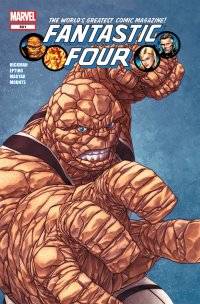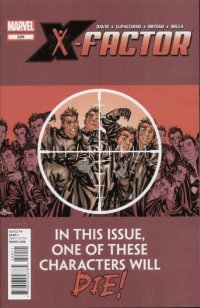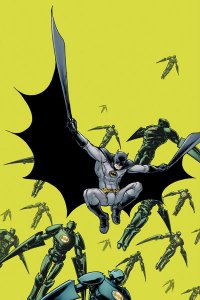Fantastic Four #601 (Marvel, $2.99)
By Jeb D.
One thing the spate of recently-recruited indie writers now working for Marvel seem to have in common is the ability to roll with the commercial punches of death/rebirth, crossover/event, renumbering/relaunch, and sundry gimmicks, and simply tell a superhero story that honors convention while introducing just enough tweaks and turns to keep things interesting. Up to this point, Jonathan Hickman’s Fantastic Four/FF series has been thought-provoking, nostalgic, large-scale, forward-looking and quirky. Now, with the return of Johnny Storm, and the bifurcation of the two storylines into the Fantastic Four and the Future Foundation, Hickman delivers one of his best issues yet: it’s old-school “earthly heroes versus hordes from space” stuff, and reminds you why these well-worn tropes can continue to be effective.
There’s not much to say about the plotting, as it follows closely on the epic issue #600: the reborn Kree Supreme Intelligence has amassed an armada to destroy Earth, and things are looking dark: destruction rains down as Ben’s outnumbered, and Kree soldiers employ a suicide weapon to take out Sue’s force field (“Weep that you will never see the burning skies of Hala again” the commander grimly informs his men). Hickman wisely picks up Johnny’s return at the moment that Spider-Man found him (“You died.” / “More than once. Still better looking than you. Here, hold my Annihilus.“), and proceeds, in just a few exchanges with the rest of the FF, to make a convincing case for Johnny’s increased maturity in the face of his ordeal in the Negative Zone. The editing shifts the points of view-from the Kree fleet to the earthbound Avengers to the Inhumans to the FF’s space-born defiance of overwhelming odds-sharply and skillfully, and the cliffhanging conclusion is perfectly judged.
No one needs me to tell them that Steve Epting has this epic superhero storytelling down: our heroes are all beautiful and resolute, the villains imposing; and from Hitch-like widescreen to the range of facial expressions, he makes every panel count (as the world comes apart around her, he gives Alicia’s face a look of horror that conveys the frightening confusion of being blind in the face of such catastrophe). He’s aided by Rick Magyar and Mark Pennington on inks, and Paul Mounts’ color palette is completely contemporary without losing the flavor of the best post-Kirby FF stories; more than anything else, the Hickman/Epting team reminds me of the book’s Lee/Buscema era. And if, like me, you’ve been jonesing for a full-page “It’s Clobberin’ Time!” panel, Mr. Epting has you covered.
Rating a comic like this in an exercise in context: there’s nothing in it you haven’t seen before. But if you can still get caught up in a blockbuster superhero saga, well-told, with memorable authorial touches, you won’t do better. Can’t wait for next issue.
Rating: 




Out of a Possible 5 Stars
 The Last Battle One Shot (Image Comics, $7.99)
The Last Battle One Shot (Image Comics, $7.99)
By D. S. Randlett
It might be a little obvious to say that Ridley Scott’s Gladiator began a minor resurgence of the swords and sandals genre to the cinema. It also kicked off a new way that our media interpreted and presented Rome. In the age of Iraq, Rome has become an even starker mirror than it once was. The state flag of Virginia is emblazoned with the words of the elder Brutus, a representation of our young nation’s feeling of brotherhood with that revolutionary spirit. The former British colonies were going to breathe liberty into the world again. For a long time, we chose to see Rome as a mirror of the finer virtues. As American power has risen, the mirror has darkened. We are more enraptured by Rome’s tragedies than we are its young hopes, for the tragedies encapsulate what is worth fearing in power. This is reflected in films like Centurion, or The Eagle where characters on some frontier or other are confronted with what has gone wrong with their own culture. They are stories of the betrayal that happens when power and war corrupt ideals. The Last Battle is such a story, but it has a few flourishes that set it apart from other stories in the “disappointed Roman” subgenre.
General Caius Rodius is, apparently, a legend. He trained Caesar into the man who would end the Roman Republic, and when the two walk before a crowd of soldiers, Rodius is who they fawn over. Of course, he also happens to be a staunch republican (in the Roman sense), and he is extremely popular, which sets up some friction between him and Caesar’s goals. Rodius is called out of retirement to deal with the leader of a cohort of reinforcements headed to Alesia, the site of what will turn out to be the deciding battle in Caesar’s Gallic campaign. The problem for Rodius is that the leader of these forces is a man named Cammius, who Rodius found as an orphan and subsequently raised as his own son. But still, orders are orders, and Rodius finds himself rounding his elite team up for this one last mission.
From there, the story doesn’t deviate so much from the modern swords and sandals adventures that we’ve seen in film recently, but the book does manage to find a few ways to set itself apart. First, it manages to strike a very different tone. Reading The Last Battle, I was struck by some very fun tonal touches that reminded me of film directors like Sergio Leone and Sam Peckinpah. In other words, this book isn’t afraid of brawn. That brawn doesn’t come at the expense of the sense that the principal characters have actual interiors, either. Rodius in particular has a well drawn, if terse, personality, something a lot of these stories fail to really get right. The book is also more faithful to the spirit of history than to the facts. Where it benefits the overall feel, creators Tito Faraci and Dan Brereton aren’t afraid to bring in influences from horror and fantasy to keep things just exotic enough.
Dan Brereton’s art is the obvious highlight here. The style he adopts for this book is sort of a combination to the heroic styles of Cary Nord and Bruce Timm, which fits this story perfectly. The colors are just gorgeous to look at, as well.
Rating: 




Out of a Possible 5 Stars
X-Factor #229 (Marvel, $2.99)
by Graig Kent
(Warning, SPOILERS ahead)
For roughly 80 issues, over 6 years, with a slew of artists (often a rotating roster), and more twists and turns than a mountainside highway, Peter David has been plugging away at one of the few remaining comics operating with soap opera-style storytelling, a style that’s been slowly abandoned by the industry as a whole over the past decade. With trade paperbacks being the growth area and primary focus for attracting the less frequent reader, telling stories not even in long-form but with no-end-in-sight doesn’t make for a financially attractive proposition. I honestly can’t think of another current title at the Big Two that has retained the same writer for as long that hasn’t be subject to the event steamroller (either being the driving force behind an event, like Bendis’ Avengers, or had drastic changes as a result of an event or movie tie-in, like Brubaker’s Captain America). X-Factor is such an under-the-radar book, and its cast are such, at best, B-list characters, that they’re never going to have the spotlight on them in such a manner as to drum up an event around them nor have any monumental impact on the larger events of the Marvel universe. Once you accept their status as second-string superheroes as Peter David has, absolving them (and himself) of next to all ego, the book makes for a tremendous ride.
X-Factor re-emerged in the mid-aughts after a surprising and successful Madrox mini-series by David that tweaked the character of Jamie Madrox, the Multiple Man, from background character into a Fletch by way of Raymond Chandler-style gumshoe. Since then, Madrox has without a doubt been the central figure of the ever-expanding ensemble that is X-Factor, a mutant detective agency that handles odd cases and actively tries to avoid the larger events in the superhero community. Even within a compartmentalized “Mutant Universe” of X-Titles, X-Factor has, by and large, managed to further segregate itself into its own little fiefdom, where even the mandated crossover David manages to work into the series in an organic and unobtrusive manner. He has his own fish to fry, and his characters are often far too preoccupied by the events of their own lives to care about whatever alien invasion or monster rampage is taking place in the universe around them.
With the previous issue, David delivered his latest cliffhanger, a shock to the status quo wherein Jamie Madrox was killed. Now, for a guy who is capable of duplicating himself with a stomp of the foot, seemingly ad nauseum, there seems to be an easy out for bringing him back. But David was pretty explicit in his wording to note that it was “Madrox prime” or the “Alpha Madrox”, the main man, the host himself who bit the bullet (or was gored with a magic sword, as it were). This was as big as other such memorable cliffhangers, such as when Layla Miller got abandoned in a dystopian future or when Madrox absorbed his own baby shortly after Syrin gave birth to it. For one month the prospect of an X-Factor title without its figurehead character was a baffling prospect, though I had no doubt David could make it work, I just wasn’t sure I wanted it to.
But with issue number 229, David immediately provided an out, nodding (and winking) towards other, more recent, higher-profile deaths (Steve Rogers, Bruce Wayne) and, moreover, their convoluted rebirths. Taking a note from Batman’s and Captain America’s jumping through time and space, Jamie Madrox is bouncing across parallel universes, emerging as a renegade dupe from Madrox primes as they themselves die horrible horrible deaths (did I mention SPOILERS). It’s the start of a tale that can only be called “They Keep Killing Madrox”, which is Peter David’s morbid sense of humor in a nutshell.
With Jamie gone, team X-Factor is left to pick up the pieces, Wolfsbane still reeling from birthing her demon spawn a few issues ago, Strong Guy coping to life without a soul, Rictor having regained his powers and Layla Miller shattered (since some of the stuff she knows can’t possibly come true if Madrox is dead). This issue doesn’t get into much of that, as David utilizes Madrox’s dimension-hopping as a means to show how certain storylines would have played out in a “What If…?” manner. It’s exceptionally playful and moving in a complete 180 degrees from the dourness that threatened to overtake the book over the events of the past year.
David has, over the years, proven exceptionally adept at balancing the drama with levity, solemnity with action, and just making the book a continually enjoyable, and, at times, evocative read. Though it may prove a bit to “inside-baseball” to be the best jumping-on point for new readers, it is a big reminder of what type of book it is and why its loyal readers keep reading it.
Rating: 




Out of a Possible 5 Stars
 Batman Inc: Leviathan Strikes One-Shot (DC, $6.99)
Batman Inc: Leviathan Strikes One-Shot (DC, $6.99)
By Adam Prosser
No book has been hamstrung by the hasty relaunch of the New 52 like Grant Morrison’s Batman, Inc., and no other book, to me, demonstrates just what a knee-jerk, desperate move the whole enterprise was in the first place. Morrison’s work on Batman has been inconsistent, but frequently brilliant, and with the launch of Batman, Inc. he had entered perhaps the most interesting phase of the whole experiment. BI synthesized all the ideas that Morrison had been playing around with—the neo-Silver Age stuff, the trippy mind games, the attempt to reframe Batman in a new context for the 21st century—into a potent stew that also played off plotlines that had been building for years, in some cases since the beginning of his run. And just as it was cooking along nicely, heading towards the big reveal of exactly who was behind Leviathan, the whole thing hit a brick wall as the entire DC Universe hit the reset button. There was no place for the intricate, ongoing storylines, dense world-building and character history of Batman, Inc. in the dumbed-down, plain vanilla world of the DCnU. The comic vanished from the stands after a rather disappointing “cyberspace” issue (which also had the bad luck of featuring Oracle, a character who was about to be rendered irrelevant—and replaced with a far less interesting character–by the reboot).
But Morrison has clout with DC, and several issues of Batman, Inc. were still on the drawing board, so the comic wasn’t abandoned. Instead, it’s being allowed to limp onwards to a conclusion, one that might still be entertaining if you can clutch your ears and block out the cacophony from the reboot, screaming that this book is now “out of continuity”, that it no longer matters, that it’s a relic of the old way of thinking. Or is it that this book stands as an embarrassing example of a baby that DC wasn’t quite able to throw out with its bathwater?
This comic is clearly a hastily-stitched-together compilation of at least two comics. In the first half, drawn by the always-welcome Cameron Stewart, Stephanie Brown’s Batgirl (yet another character who’s been stupidly tossed aside in the reboot—it’s like Morrison is deliberately trying to remind us of what we’ve given up) infiltrates a girl’s school that’s secretly a training ground for assassins…WITH SEXY RESULTS! I’m only half-joking—Stewart is, as anyone who cares about such things knows, the greatest rendererer of women in mainstream comics right now, making them sensual without being exploitative, and his art is actually a bigger draw in the first chapter than Morrison’s straightforward (for him) story. It does put Batman on the trail of Leviathan, opening the door for the much more ambitious and balls-out crazy second half, in which the Bruce Wayne Batman, the Dick Grayson Batman, Red Robin, and Damien Wayne infiltrate the mind-maze of Doctor Daedalus, who you may remember from earlier issues of the series. There’s a lot of weird time-jumps and hallucinations that make it kind of hard to tell exactly what’s going on in this story, in true Morrisonian fashion, but it builds to a nonetheless exciting climax with a lot of fascinating if sometimes half-baked ideas (again, typical for Morrison) and a twist that seems logical enough, though as presented I felt it made Leviathan rather less interesting and more generic than I would have hoped, more like something we’ve seen before. That’s just an initial impression, though, and the stage is set for an interesting conclusion to Morrison’s bat-saga, which will thankfully be coming in the new year; it would have been spectacularly lame to leave Morrison’s epic, which has been rolling forward for over fifty issues across multiple titles, without a true ending.
In an interesting article earlier this year,Paul Gravett responded to Morrison’s book “Supergods” and a few other aspects of his recent work by levelling the accusation that he’d become a “company man”. There is, sadly, a certain amount of evidence to support this, the suggestion that Morrison is now working more to serve the interests of DC, the company, than he is in creating worthwhile works of comic book art, to the point where he may be creating apologias for corporatism; certainly this is how Batman, Inc. sometimes reads. But, hearteningly, there’s also evidence that Morrison is going through a philosophical phase before transforming his worldview once again; certainly it’s impossible to read his oft-overlooked (but awesome) collaboration with Stewart Seaguy, which has been running roughly alongside his Batman work, and not conclude that he’s well aware of the downside of gigantic corporations controlling the art and entertainment we consume. This tension is definitely present in Batman, Inc, and it makes it a far more interesting book than most superhero comics right now can dream of being. The superficial reading is that we’re seeing Batman as a force of corporate globalization, fighting a shadowy league of anarchists (whose enforcer has a rather explicit visual link to Islam) and it’s hard not to get queasy flashbacks to Frank Miller’s “Holy Terror”. But it’s just as easy to see Batman, Inc. as a potentially huge mistake on Bruce’s part, one that will be subverted massively before the series is over, and if the mindless unanimity of Leviathan doesn’t at least partly represent the crushing conformism of capitalist culture in general and comics in particular, I’ll eat my hat. It’s certainly not hard to imagine Grant Morrison struggling with these issues from within the belly of the beast, watching his creative work get steamrolled by massive changes beyond his control by a faceless corporation, and not imagine him getting ready to go out with a bang. Since, for Morrison, comics and real life are interchangeable, one would hope that all this is building to something really fascinating, for both readers and watchers of the industry…
Rating: 




Out of a Possible 5 Stars